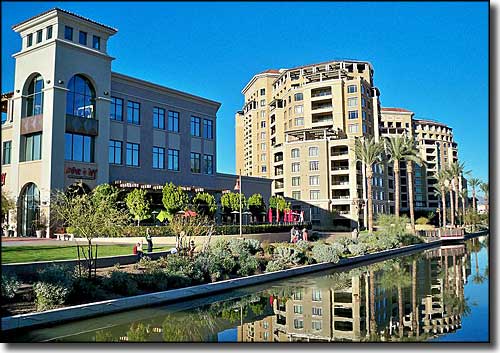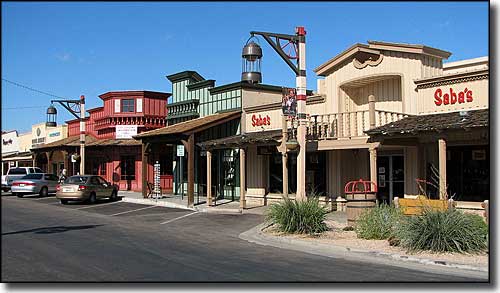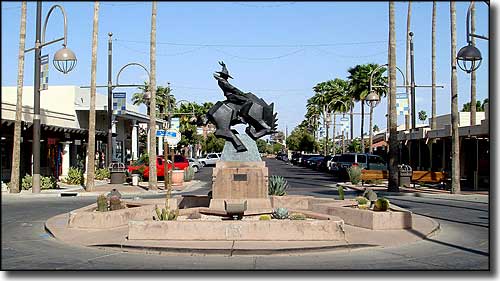
Scottsdale, Arizona

On the Waterfront, downtown in Scottsdale
An upscale tourism and shopping destination, Scottsdale is often referred to as "Arizona's version of Miami's South Beach." Being on the eastern side of the Phoenix Metroplex, Scottsdale still shows some signs of the original Hohokam irrigation canals that allowed them to farm this area of the Valley of the Sun from about 800 CE to maybe 1450 CE. After a couple hundred years of no population, some Pima moved into the area and their descendants are still located nearby. Then came the Europeans...
US Army Chaplain Winfield Scott paid $2.50 per acre for that 1 square mile that is now known as Old Town. The settlement was first known as Orangedale and Scott's brother, George Washington Scott, was the town's first resident. The name was changed from Orangedale to Scottsdale in 1894.
1937 saw Frank Lloyd Wright, an internationally renowned architect, set up his Taliesin West "winter camp" near the foot of the McDowell Mountains near Scottsdale. His influence (as an architect) is written all around the Valley of the Sun now.
The days before the big developers arrived saw a number of large manufacturing plants built in Scottsdale. From the 1950's into the 1970's, these manufacturers contributed a significant amount of the solvent trichloroethylene to the area's water aquifer. In 1983, the Environmental Protection Agency added the "Indian Bend Wash" site (which stretched almost completely across Scottsdale from north to south) to the National Priorities List of superfund sites. The cleanup systems were built and put into operation in 2006, with projected cleanup of the groundwater in the area set to be complete in 2036.
The early part of Scottsdale was sandwiched in between Phoenix on the west and an Indian Reservation on the east. In the early 1970's, the McCormick Ranch along Scottsdale's then-northern boundary, came on the market and was bought up, mostly by developers. Scottsdale annexed the area and with the added tax revenues, was able to almost completely reconstruct the faded and decayed original downtown area, adding a new performing arts center and restaurant row. Between the high-end homes in what was McCormick Ranch and the renovation of downtown, Scottsdale quickly morphed into the upscale destination that it is now.
Scottsdale is now the sixth largest city in Arizona, with a high quality of life that is financed by the high cost of living there. The southern area of Scottsdale was long the area for the working class folks, but that area is presently being transformed into a major center for the arts and for nightlife in the Valley of the Sun. Just north of South Scottsdale is Old Town, the original business center on the land bought by Winfield Scott so many years ago. Old Town still serves as the primary cultural district of Scottsdale with many fashion stores, boutiques, art galleries, bars, restaurants and nightclubs that hark back to the era of the cowboys. Old Town is also home to the Scottsdale Fashion Square Mall, one of the 20 largest shopping malls in the US. North of Old Town is the Shea Corridor, an area that was mostly developed in the 1970's. This is some of the most highly desired real estate in the whole Valley of the Sun, and is also home to a dozen major resorts (in the United States, only New York City has more AAA Five-Diamond hotels and resorts than Scottsdale). North Scottsdale is the newest (and least developed) part of Scottsdale. Home prices in North Scottsdale tend to be more than double those in South Scottsdale, with many properties in North Scottsdale valued at $5 million and more. The Scottsdale Airpark, the second largest employment center in all of the Valley of the Sun, is near the residential area of North Scottsdale. With more than 55,000 on-site employees and about 2,500 individual businesses already, the Scottsdale Airpark may well become the single largest employment center in the Phoenix Metroplex by 2010.

Shops in the Old Town District of Scottsdale

"Jack Knife," at the entrance to the Scottsdale Arts District
Zip Codes: 85250-85252, 85254-85262, 85266, 85367, 85271
Latitude: 33.5417°N
Longitude: 111.92°W
Incorporated: 1951
Elevation: 1,257'
Education:
High School or Higher: 93.5%
Bachelor's Degree or Higher: 44.1%
Graduate or Professional Degree: 14.7%
2011 Cost of Living Index for Scottsdale: 96.3
Estimated Median Household Income: $71,600
Estimated Median Home Value: $419,500
Median Resident Age: 41.0 Years
Major Industries:
Professional Services, Finance & Insurance Services, Lodging & Food Services, Educational Services, Construction, Health Care, Real Estate Services, Computers & Electronic Parts, Waste Management Services
Unemployed (March 2011): 6.4%
2010 Population Demographics
| Total Population | 217,385 |
| Males | 104,930 |
| Females | 112,455 |
| Population by Age | |
| Under 18 | 38,590 |
| 18 & over | 178,795 |
| 20-24 | 10,899 |
| 25-34 | 26,446 |
| 35-49 | 44,444 |
| 50-64 | 49,714 |
| 65 & over | 43,471 |
| Population by Ethnicity | |
| Hispanic or Latino | 19,225 |
| Non Hispanic or Latino | 198,160 |
| Population by Race | |
| White | 194,062 |
| African-American | 3,652 |
| Asian | 7,239 |
| Native American | 1,741 |
| Hawaiian or Pacific Islander | 208 |
| Other | 5,525 |
| Two or more | 4,958 |
